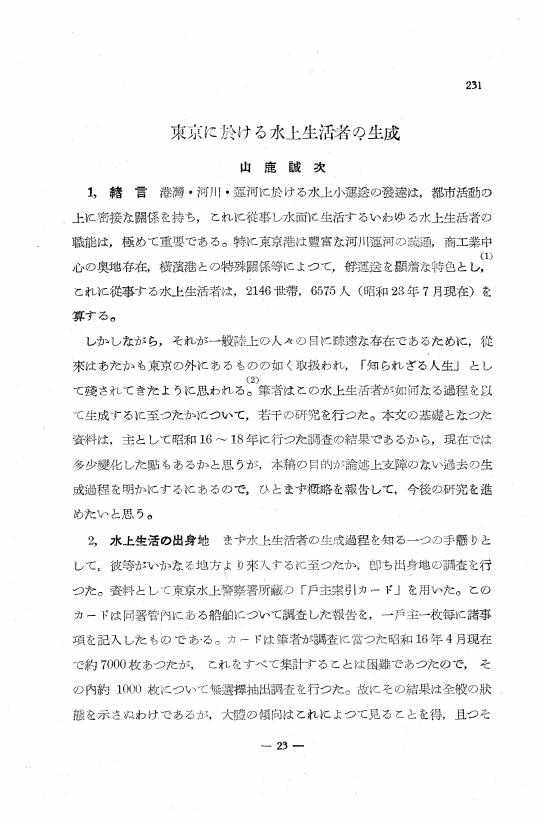2 0 0 0 OA 東京都清瀬町の都市化—大都市周辺における病院町の成立—
- 著者
- 山鹿 誠次
- 出版者
- The Association of Japanese Geographers
- 雑誌
- 地理学評論 (ISSN:00167444)
- 巻号頁・発行日
- vol.32, no.1, pp.35-41, 1959-01-01 (Released:2008-12-24)
- 参考文献数
- 3
- 被引用文献数
- 1
The writer has studied the process by which the city functions, developing towards the urban fringes, incited the urbanization of suburbs. Special hospitals for the patients of such diseases as tuburculosis, mental disease and infectious diseases seek their sites in the suburbs of the metroplis, because there they can get capacious grounds, quiet environment and fresh air. When we see the distribution of the special hospitals in Tokyo, we find that most of the newly established hospitals are situated in the urban fringe, and some of the older ones built in the inner region, have removed centrifugally to the outshirts. Kiyose town is in the western suburbs of Tokyo, and on the Musashino Upland. It was formerly a farm-village, , but since 1331 many tuburculosis hospitals have been established in the pine forests of the south-western area of this town, and so Kiyose has become one of the largest hospital quarters in Japan, having 14 hospitals, 4, 821 beds, and 25% of its whole ares is covered by hospitals. Consequently, the population increased rapidly and the shopping street developed between the, hospital quarters and the railway station. Moreover many residential houses were recently built, and this town has also grown into one of the residential districts of Tokyo. Through the study of Kiyose and some other hospital quarters in Tokyo, the writer has come to the conclusion that there are some grades in the relations between the special hospitals and the urbanization in the metropolis. The grades are as follows: (1) Special hospitals were first established in the innermost region of the metropolis, but with the development of the metropolis, they moved to the outer regions, or were turned into general hospitals. (2) In the region next to the former innermost region of the metropolis, the hospitals which were established in the days when the region were the suburbs are now in the residential districts which have developed since their establishment. (3) In the next region, urbanization is in advance, and there the hospital quarter and the residential district are contiguous to each other. (4) In the outermost region of the metropolis, hospitals are situated apart from other establishments, and the residential district has not advanced into this region yet. Kiyose belongs to the third grade.
2 0 0 0 OA 日本における衛星都市の研究
- 著者
- 山鹿 誠次
- 出版者
- The Association of Japanese Geographers
- 雑誌
- 地理学評論 (ISSN:00167444)
- 巻号頁・発行日
- vol.36, no.3, pp.159-168, 1963-03-01 (Released:2008-12-24)
- 参考文献数
- 23
日本における衛星都市の性格・類型およびそのような性格の生じた要因について分析し,さらに衛星都市群の形成とその発達要因について考究した結果,次のような結論を得た。 (1) 衛星都市は巨大都市の周辺にあつて,巨大都市と密接な関係をもつて発達し,巨大都市の機能の一部を分担する中小都市である. (2) 衛星都市の性格は大都市と地方都市のいずれとも異なり,その複合性・半独立性をもつ。しかしその中には,従属型・半独立型・複合型などいくつかの類型がある. (3) 衛星都市性格形成の要因としては住宅・工業・学園など大都市機能の遠心的拡大によつて,大都市的性格が付与され,一方既存都市の変質や母市からの隔離によつて半独立性が要求され,この二つが複合した性格をおびるに至つたためである. (4) 日本の三大衛星都市群を対比すると,大阪中心のものが最も早く発達し,東京中心のものがこれにっいで,第2次大戦の影響を強くあらわし,名古屋中心のものは近年発展しつつある。このような差異には,三大都市圏における諸種の地理的条件が反映している。
2 0 0 0 衛星都市としての浦和の機能--大都市圏の拡大に伴う地方都市の変質
- 著者
- 山鹿 誠次
- 出版者
- 日本地理学会 古今書院(発売)
- 雑誌
- 地理学評論 (ISSN:00167444)
- 巻号頁・発行日
- vol.24, no.8, pp.283-289, 1951-08
1 0 0 0 OA 東京に於ける水上生活者の生成
- 著者
- 山鹿 誠次
- 出版者
- The Association of Japanese Geographers
- 雑誌
- 地理学評論 (ISSN:00167444)
- 巻号頁・発行日
- vol.23, no.7, pp.231-237, 1950-07-31 (Released:2008-12-24)
- 参考文献数
- 7
- 被引用文献数
- 1
